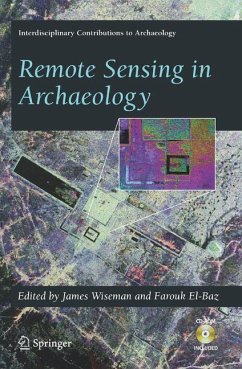
Confronting Scale in Archaeology
Issues of Theory and Practice
Herausgegeben: Lock, Gary; Molyneaux, Brian
Versandkostenfrei!
Versandfertig in 1-2 Wochen
75,99 €
inkl. MwSt.

PAYBACK Punkte
38 °P sammeln!
Without realizing, most archaeologists shift within a scale of interpretation of material culture. Material data is interpreted from the scale of an individual in a specific place and time and then shifts to the complex dynamics of cultural groups extending over time and space. This ignoring of scale is the "concession" archaeologists make to interpretation. The introduction of geographical information systems (GIS) remote sensing, and virtual reality have expanded the scale at which data is interpreted even more, using multiple scales at the same time without recognizing the significance of their actions.
This book discusses the cultural, social and spatial aspects of scale and its impact on archaeology in practical and applicable cases. Each author takes one of the fundamental elements of archaeology - from the experience of time and space to the visualization of individuals, sites and landscapes to the intricacies of archaeological discourse - and shows how an awareness of scale can create new and exciting interpretations.
This book discusses the cultural, social and spatial aspects of scale and its impact on archaeology in practical and applicable cases. Each author takes one of the fundamental elements of archaeology - from the experience of time and space to the visualization of individuals, sites and landscapes to the intricacies of archaeological discourse - and shows how an awareness of scale can create new and exciting interpretations.
Archaeological analysis operates on a continuum of scale from the microscopic analysis of a single artifact to regional interpretations of cultural adaptations over thousands of years. A common assumption is that shifting from one scale to another in space and time is a seamless process. Scale in this sense is invisible, a mere mathematical abstraction. Yet, issues of scale exist at the fundamental level of archaeological interpretation. The traditional analytical debate in archaeology - between advocates of the so-called ''processual'' and ''postprocessual'' approaches - ranges around the question of scales of reasoning. At the one extreme, remote observation and the ability to interpret events and processes over vast reaches of time and space are possible, because the analysis concerns the hoped-for elucidation of general cultural processes; at the other, they are not, as both analyst and subject are isolated in their own subjectivities. Analysts occupying the middle ground often advocate a ''multidimensional'' or ''holistic'' approach, which involves multiple scales of analysis and interpretation. As the battleground tends to be the degree to which specific datasets and analytical processes justify the interpretations put forth, archaeologists rarely - dress issues relating to the profound shifts in the scale of visualization necessary in all approaches to the past. And why should they? Ignoring scale is the concession archaeology makes to interpretation.














